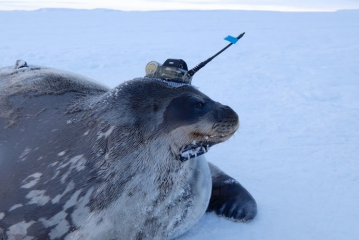12_Seal_edit.png

Scientists used Weddell seals to gather environmental data where humans can’t easily go: underneath the ice. Credit: Nobuo Kokubun (NIPR).
Marine scientists need all the help they can get. Exploring the oceans is hard and expensive. In recent years, though, they’ve gotten help from some special research assistants: marine mammals. They attach small cameras or instruments to seals, whales, and other animals. Their journeys tell us a lot about ocean conditions, ocean life, and the animals themselves.
One recent example is a project that used Weddell seals to study conditions below and near the ice sheets in East Antarctica. The waters there are among the most productive on the planet—the result of interactions between the ice and the ocean water. Strong winds during fall and winter appear to make the waters even more productive, enhancing the abundant life.
It’s almost impossible to explore that region during the winter, though. So, a team of scientists glued small instruments to the heads of eight Weddell seals. The instruments recorded temperature, salinity, and depth. When the seals came to the surface, the observations were relayed through a satellite.
The instruments operated from March to September of 2017. They showed that the seals traveled up to 400 miles from shore, and reached depths of a third of a mile. They also revealed that warmer, fresher water flowed into the ocean in late fall, and expanded into deeper waters in winter. That appeared to boost the food supply for the seals. The test also demonstrated that seals make good research assistants—going where scientists can’t.

